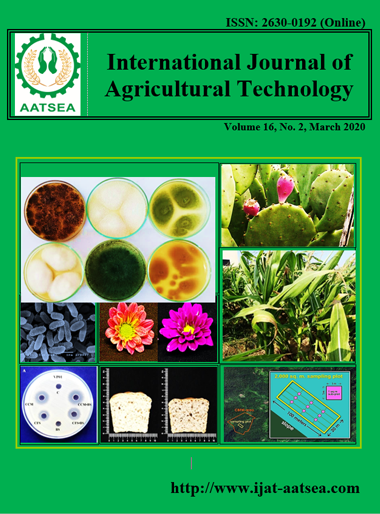Residual effects of intercrop system and rice as mono crop on growth and yield of maize in rice-based production system
Main Article Content
Abstract
The plot previously planted with maize, peanut and sweet potato as intercropping system had higher organic matter, available phosphorus, exchangeable potassium, exchangeable magnesium extractable iron, manganese, zinc and copper, than the plot previously planted with rice as mono crop. The results suggested that intercropping system improved soil quality and might be beneficial to succeeding crops. Maize and rice grown after intercropping system were not significantly different for growth parameters, yield and yield components. Maize grown after intercropping system was better than its grown after rice because of higher yield (7,895 kg/ha and 8,558 kg/ha) for the plot after rice harvest and the plot after intercropping system. The results indicated that maize cultivation could be decreased in rice cultivation in irrigated areas of the dry season. It is possible the rice growers can select both systems.
Article Details

This work is licensed under a Creative Commons Attribution-NonCommercial-NoDerivatives 4.0 International License.
References
Ali, M. Y., Waddington, S. R., Hodson, D., Timsina, J. and Dixon, J. (2009). Maize-rice cropping systems in Bangladesh: Status and research opportunities. Journal of Agricultural Science and Technology, 3:35-53.
Ball, B. C., Bingham, I., Rees, R. M., Watson, C. A. and Litterick, A. (2005). The role of crop rotations in determining soil structure and crop growth conditions. Canadian Journal of Soil Science, 85:557-577.
Bray, R. H. and Kurtz, L. T. (1945). Determination of total organic and available forms of phosphorus in soil. Soil Science, 59:39-45.
Bricker, A. A. (1989). MSTAT-C User’s Guide. Michigan State University, East Lansing, MI.
Bullock, D. G. (1992) Crop rotation. Critical Reviews in Plant Sciences, 11:309-326.
Eskandari, H., Ghanbari, A. and Javanmard, A. (2009). Intercropping of cereals and legumes for forage production. Notulae Scientia Biologicae, 1:07-13.
Gbanguba, A. U., Ismaila, U., Kolo, M. G. M. and Umar, A. (2011). Effect of cassava/legumes intercrop before rice on weed dynamics and rice grain yield at Badeggi, Nigeria. African Journal of Plant Science, 5:264-267.
Kermah, M., Franke, A. C., Adjei-Nsiah, S., Ahiador, B. D. K., Abaidoo, R. C. and Giller, K. E. (2017). Maize-grain legume intercropping for enhanced resource use efficiency and crop productivity in the Guinea savanna of northern Ghana. Field Crops Research, 213:38-50.
Kombiok, J. M., Buah, S. S. J. and Sogbedji, J. M. (2012). Enhancing soil fertility for cereal crop production through biological practices and the integration of organic and inorganic fertilisers in northern savanna zone of Ghana. Intech online publishers.
Latati, M., Bargaz, A., Belarbi, B., Lazali, M., Benlahrech, S., Tellah, S., Kaci, G., Drevon, J. J. and Ounane, S. M. (2016). The intercropping common bean with maize improves the rhizobial efficiency, resource use and grain yield under low phosphorus availability. European Journal of Agronomy, 72:80-90.
Li L., Zhang, F. S., Li, X. L., Christie, P., Yang, S. C. and Tang, C. (2003). Interspecific facilitation of nutrient uptake by intercropped maize and faba bean. Nutrient Cycling in Agroecosystems, 65:61-71.
Li L., Li, S. M., Sun, J. H., Zhou, L. L., Bao, X. G., Zhang, H. G. and Zhang, F. S. (2007). Diversity enhances agricultural productivity via rhizosphere phosphorus facilitation on phosphorus-deficient soils. Proceedings of the National Academy of Sciences, USA, 104:11192-11196.
Lindsay, W. L. and Norvell, W. A. (1978). Development of a DTPA soil test for zinc, iron, manganese and copper. Soil Science Society of America Journal, 42:421-428.
Marenco, R. A. and Santos, A. M. B. (1999). Crop rotation reduces weed competition and increases chlorophyll concentration and yield of rice. Pesquisa Agropecuaria Brasileira, 34:1881-1887.
Marer, S. B., Lingaraju, B. S. and Shashidhara, G. B. (2007). Productivity and economics of maize and pigeonpea intercropping under rainfed condition in northern transitional zone of Karnataka. Karnataka Journal of Agricultural Science, 20:1-3.
Mathews, C., Jones, R. B. and Saxena, K. B. (2001). Maize and pigeonpea intercropping systems in Mpumulanga, South Africa. International Chickpea and Pigeonpea Newsletter, 8:53.
Ortiz-Ceballos, A. I., Aguirre-Rivera, J. R., Salgado-Garcia, S. and Ortiz-Ceballos, G. (2015). Maize- velvet bean rotation in summer and winter milpas: a greener technology. Agronomy Journal, 107:1:330-336.
Richards, L. A. (1954). Diagnosis and Improvement of Saline and Alkali Soil. USDA Agriculture. Handbook 60. Washington, D. C.
Rusinamhodzi, L., Corbeels, M., Nyamangara, J. and Giller, K. E. (2012). Maize–grain legume intercropping is an attractive option for ecological intensification that reduces climatic risk for smallholder farmers in central Mozambique. Field Crops Research, 136:12-22.
Schmidt, G. and Frey, E. (1992). Cropping systems research at the Nyankpala Agricultural Experiment Station. In Improving farming systems in the interior savanna zone of Ghana. Acquaye and NAES (ed.), pp. 14-35.
Senaratne, R., Liyanage, N. D. L. and Soper, R. J. (1995). Nitrogen fixation of and N transfer from cowpea, mungbean and groundnut when intercropped with maize. Fertilizer research, 40:41-48.
Sparks, D. L., Page, A. L., Helmke, P. A., Loeppert, R. H., Soltanpour, P. N., Tabatabai, M. A., Johnston, C. T. and Summer, M. E. (1996). Lithium, sodium, potassium, rubidium, and cesium. Bertels, J. M. editor, Method of soil analysis part 3 chemical methods, Medison Soil Science Society of America, pp.551-574.
Thierfelder, C., Cheesman, S. and Rusinamhodzi, L. (2012). A comparative analysis of conservation agriculture systems: Benefits and challenges of rotations and intercropping in Zimbabwe. Field Crops Research, 137:237-250.
Toomsan, B., McDonagh, J. F., Limpinuntana, V. and Giller, K. E. (1995). Nitrogen fixation by groundnut and soyabean and residual nitrogen benefits to rice in farmers' fields in Northeast Thailand. Plant and Soil, 175:45-56.
Walkley, A. and Black, C. A. (1934). An examination of Degtjareff method for determining soil organic matter and a proposed modification of the chronic acid titration method. Soil Science, 37:29-37.


